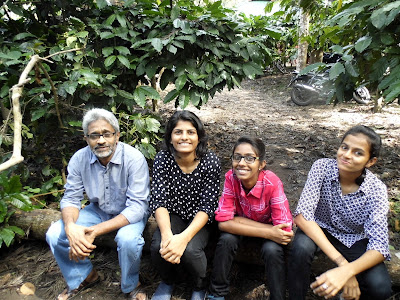“Those with
heart problems should not climb,” warns a signboard at the threshold of the
ascent to the Edakkal Caves in Wayanadu district of Kerala. My students whom I was accompanying pointed out
the board to me. “My heart is good,” I told them.
There are
quite a few places on the way that try your heart’s strength. The climb is
quite steep in those places. I did not pant a bit, however. “What is the secret
of your health, sir?” asked one of the students who was struggling for breath. “My
heart is good,” I answered.
The half-hour
ascent ends in a cave with quite a few charming slits in rocks, crevices that
let in sunbeams that light up the cave delightfully. The history of the cave
goes back to eight millennia, the official tourist guide there told us pointing
at the pictorial writings on one of the granite walls. Some of the drawings
have possible links with the Indus Valley Civilisation, says the guide. Later I
checked Wikipedia which says:
The caves contain drawings that range over periods
from the Neolithic as early as 5,000 BC to 1,000 BCE. The youngest
group of paintings have been in the news for a possible connection to the Indus Valley Civilization.
It was sheer
delight to climb that ascent and be there in that cave which is technically not
a cave but a “cleft, rift or rock shelter” [Wikipedia]. I wished I could spend
more time there. But the law permits only 5 minutes because only 30 visitors
are allowed at a time and people keep waiting eagerly for their turn. My own
group consisted of 70 members. I suppressed my desire and turned back hoping to
come again for another climb after looking at the cardiac warning at the
threshold.
In the
meanwhile, here are some pictures from this visit. I hope my students will forgive me for bringing them here in this space.
 |
| The first steps |
 |
| A view on the way |
 |
| One of the crevices |
 |
| The Cavern: the inscriptions are on the right wall |
 |
| One of the fissures right on top of the Cavern |
 |
| One of the students asked why I was not taking any of my own pic. So here it is. |


Amazing place, wish one day will visit for sure.
ReplyDeleteIt's worth visiting.
DeleteNice post and pics. You did not answer what is the secret of your good heart?
ReplyDelete:) :)
DeleteGlad you liked it. If I answer that question it will sound boastful. My students know me and they don't need an answer anyway.
I loved Edakkal caves. It was a beautiful place. I visited around 5 years ago but your post brought back memories. Check this out when you get time - https://www.happinessandfood.com/kaleidoscopic-kerala/
ReplyDeleteGlad to have revived your memories.
Delete